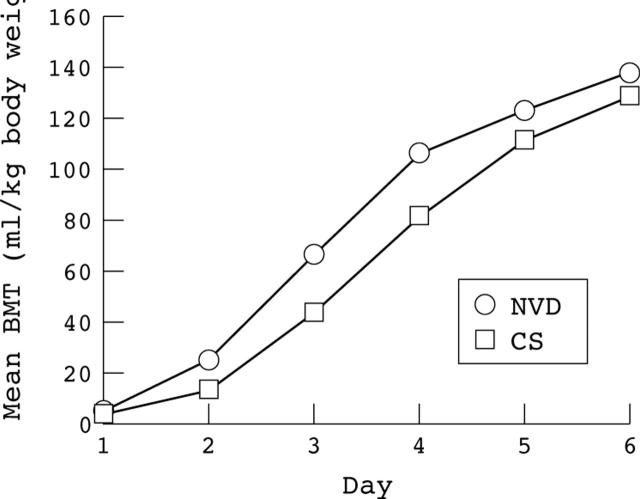Abstract
Objective: To determine the effect of caesarean section on breast milk transfer (BMT) to the normal term infant over the first week of life.
Method: A sample of 88 healthy nursing mothers who had a normal vaginal delivery, and 97 mothers who had a caesarean section were recruited from a teaching hospital. Mothers and midwives were instructed to weigh the infants before and after each feed throughout the study period using calibrated portable electronic scales.
Results: The volume of milk transferred to infants born by caesarean section was significantly less than that transferred to infants born by normal vaginal delivery on days 2 to 5 (p < 0.05), but by day 6 there was no difference between the two groups (p = 0.08). The difference could not be explained by any of the maternal and infant variables measured. Birth weight was regained by day 6 in 40% of infants born vaginally compared with 20% in those born by caesarean section.
Conclusion: There is a lag in the profile of the daily volume of breast milk transferred to infants delivered by caesarean section compared with those born by normal vaginal delivery. This study also challenges the widely followed schedules of milk volumes considered to be suitable for the term infant, which appear to be excessive, at least for the first four to five days post partum.
Full Text
The Full Text of this article is available as a PDF (52.3 KB).
Figure 1.
Profile of breast milk transfer (BMT) over the first six postnatal days to infants born by caesarean section (CS) or normal vaginal delivery (NVD).
Selected References
These references are in PubMed. This may not be the complete list of references from this article.
- Casey C. E., Neifert M. R., Seacat J. M., Neville M. C. Nutrient intake by breast-fed infants during the first five days after birth. Am J Dis Child. 1986 Sep;140(9):933–936. doi: 10.1001/archpedi.1986.02140230103044. [DOI] [PubMed] [Google Scholar]
- Nissen E., Lilja G., Matthiesen A. S., Ransjö-Arvidsson A. B., Uvnäs-Moberg K., Widström A. M. Effects of maternal pethidine on infants' developing breast feeding behaviour. Acta Paediatr. 1995 Feb;84(2):140–145. doi: 10.1111/j.1651-2227.1995.tb13596.x. [DOI] [PubMed] [Google Scholar]
- Nissen E., Uvnäs-Moberg K., Svensson K., Stock S., Widström A. M., Winberg J. Different patterns of oxytocin, prolactin but not cortisol release during breastfeeding in women delivered by caesarean section or by the vaginal route. Early Hum Dev. 1996 Jul 5;45(1-2):103–118. doi: 10.1016/0378-3782(96)01725-2. [DOI] [PubMed] [Google Scholar]
- Scanlon J. W., Brown W. U., Jr, Weiss J. B., Alper M. H. Neurobehavioral responses of newborn infants after maternal epidural anesthesia. Anesthesiology. 1974 Feb;40(2):121–128. doi: 10.1097/00000542-197402000-00005. [DOI] [PubMed] [Google Scholar]
- Scanlon J. W., Ostheimer G. W., Lurie A. O., Brown wu J. R., Weiss J. B., Alper M. H. Neurobehavioral responses and drug concentrations in newborns after maternal epidural anesthesia with bupivacaine. Anesthesiology. 1976 Oct;45(4):400–405. doi: 10.1097/00000542-197610000-00008. [DOI] [PubMed] [Google Scholar]
- Sepkoski C. M., Lester B. M., Ostheimer G. W., Brazelton T. B. The effects of maternal epidural anesthesia on neonatal behavior during the first month. Dev Med Child Neurol. 1992 Dec;34(12):1072–1080. doi: 10.1111/j.1469-8749.1992.tb11419.x. [DOI] [PubMed] [Google Scholar]



